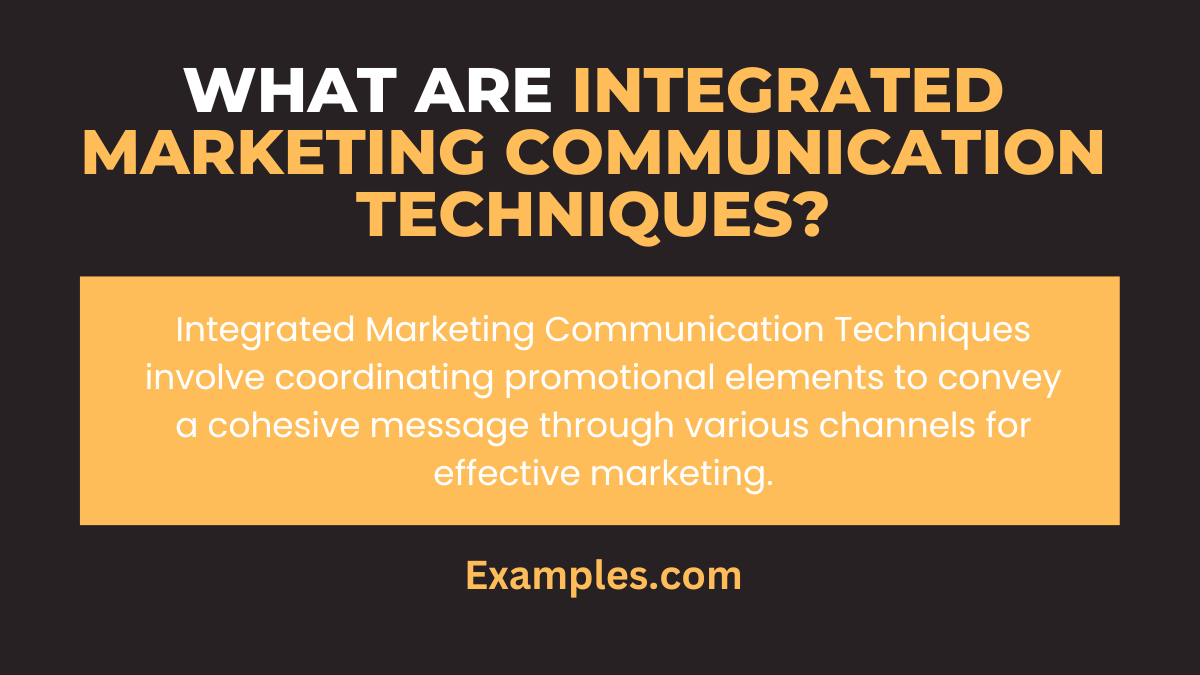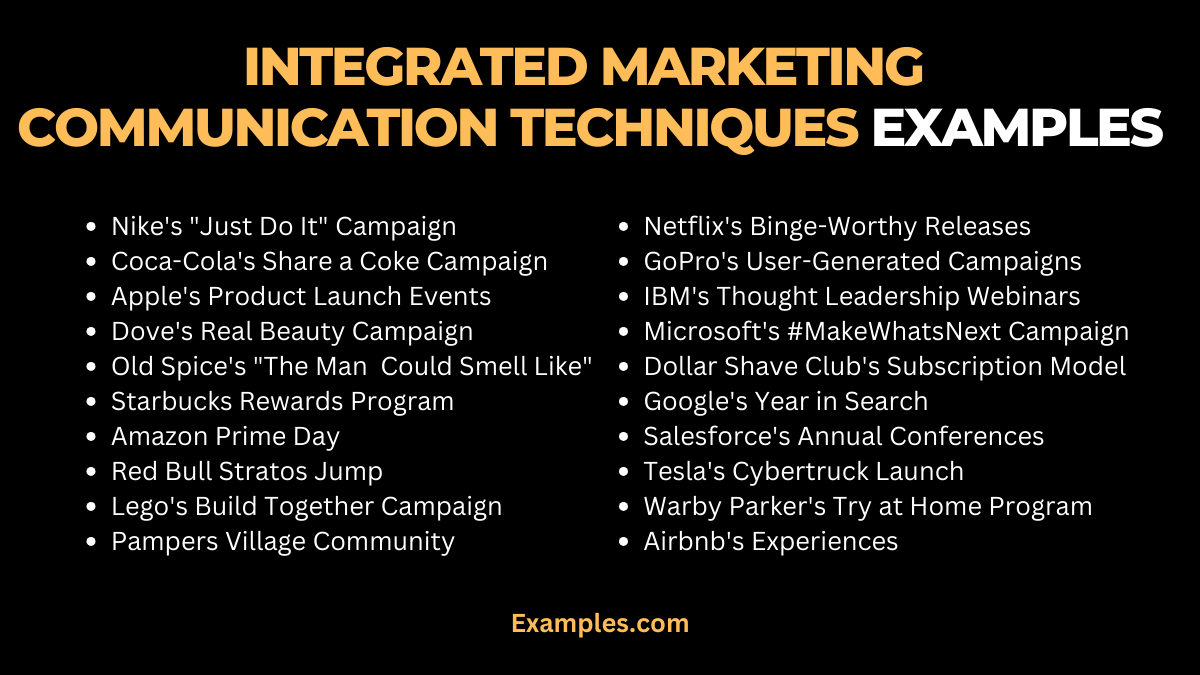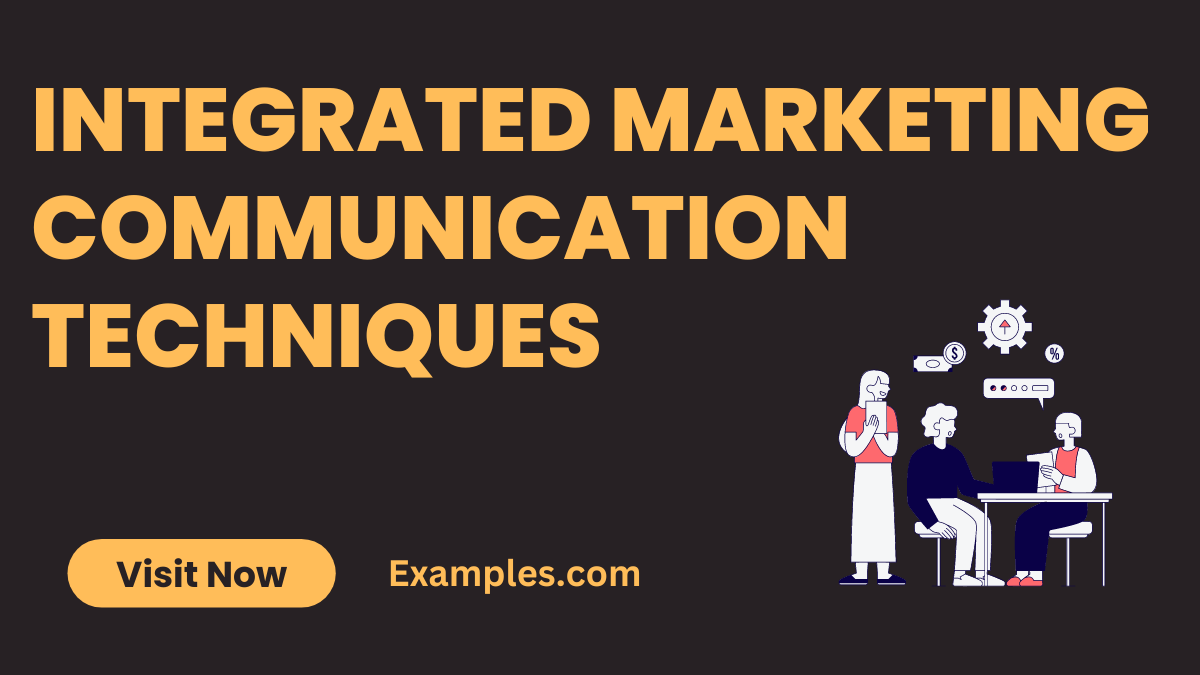19+ Integrated Marketing Communication Techniques Examples
Embark on a journey to mastery with our Comprehensive Guide on Integrated Marketing Communication Techniques. Uncover the art of blending communication strategies seamlessly for impactful results. From theory to practical examples, this guide is your key to unlocking the full potential of Communication Examples in integrated marketing.
What are Integrated Marketing Communication Techniques?

In the realm of marketing, Integrated Marketing Communication Techniques refer to the strategic integration of various communication channels to convey a unified brand message. It involves harmonizing advertising, public relations, digital marketing, and other elements to create a cohesive and consistent brand narrative.
What is the Best Example of Integrated Marketing Communication Techniques?

Delve into excellence with the exemplar of Integrated Marketing Communication Techniques: Nike’s “Just Do It” Campaign. This iconic strategy seamlessly fused TV, print, digital, and social media, establishing a powerful and unified brand message globally. Through compelling storytelling and consistent visuals, Nike achieved unparalleled success, showcasing the epitome of integrated communication mastery.
20 Integrated Marketing Communication Techniques Examples

Unlock the versatility of Integrated Marketing Communication Techniques through these 20 exemplars, each showcasing unique strategies for effective brand communication.
- Nike’s “Just Do It” Campaign: Seamlessly merging TV, digital, and social media, Nike inspires action with its iconic slogan and captivating visuals. “Just Do It” echoes in the minds of millions, promoting a can-do attitude.
- Coca-Cola’s Share a Coke Campaign: Personalization meets marketing as Coca-Cola replaces its logo with individual names, fostering a sense of connection. “Share a Coke with [Name]” became a global phenomenon, enhancing brand engagement.
- Apple’s Product Launch Events: Creating buzz through live events and online streaming, Apple sets the stage for product unveilings. “Join us for an extraordinary journey” entices global audiences to anticipate groundbreaking innovations.
- Dove’s Real Beauty Campaign: Dove challenges beauty standards through a multimedia approach, promoting diversity and self-acceptance. “Real beauty knows no bounds” communicates a powerful message of inclusivity.
- Old Spice’s “The Man Your Man Could Smell Like”: This humorous campaign combines TV, social media, and interactive websites, making “Look at your man, now back to me” an unforgettable catchphrase.
- Starbucks Rewards Program: Integrating mobile apps, emails, and in-store promotions, Starbucks fosters loyalty. “Earn stars with every sip” encourages customers to indulge while enjoying exclusive perks.
- Amazon Prime Day: Amazon creates a global shopping event by integrating promotions, exclusive deals, and social media. “Prime Day, a celebration of epic deals” entices users to join the exclusive shopping experience.
- Red Bull Stratos Jump: Red Bull integrates sponsorship across TV, online streaming, and social media. “Stratos Jump – Defying Gravity” captures the thrill of Felix Baumgartner’s historic freefall.
- Lego’s Build Together Campaign: Social media challenges, in-store events, and online content strengthen community bonds. “Build your masterpiece with Lego” encourages fans to share their creations.
- Pampers Village Community: Pampers integrates online forums, content, and social media for parental support. “Join the Village for parenting wisdom” fosters a sense of community among caregivers.
- Netflix’s Binge-Worthy Releases: Teasers, social media engagement, and targeted emails create anticipation. “Get ready to binge-watch” builds excitement around new releases.
- GoPro’s User-Generated Content Campaigns: GoPro integrates user-generated content across platforms. “Capture the extraordinary” encourages users to share their thrilling adventures.
- IBM’s Thought Leadership Webinars: Educational webinars, social media, and email campaigns establish industry authority. “Join the conversation for insights” invites professionals to engage in knowledge-sharing.
- Microsoft’s #MakeWhatsNext Campaign: Integrated social media, events, and online content empower women in STEM. “Empower the future, #MakeWhatsNext” encourages girls to pursue careers in technology.
- Dollar Shave Club’s Subscription Model: Online subscriptions, social media, and email campaigns offer a seamless user experience. “Upgrade your grooming routine” invites customers to experience convenience.
- Google’s Year in Search: Integrated online trends, video content, and social media showcase yearly highlights. “Explore the year’s defining moments” captivates audiences with compelling narratives.
- Salesforce’s Annual Conferences: Keynotes, online streaming, and interactive booths create a unified brand presence. “Discover innovation at Salesforce” engages audiences in the latest industry insights.
- Tesla’s Cybertruck Launch: Live events, online streaming, and social media set the stage for groundbreaking product launches. “Witness the future of vehicles” builds anticipation for Tesla’s revolutionary designs.
- Warby Parker’s Try at Home Program: Online orders, in-home trials, and social media create a seamless shopping experience. “Find your perfect frames” encourages customers to explore eyewear options.
- Airbnb’s Experiences: Integrated listings, reviews, and social media create a cohesive platform. “Explore unique travel experiences” invites users to discover personalized adventures worldwide.
Integrated Marketing Communication Techniques Examples for Business
Optimize business communication with these Integrated Marketing Communication Techniques. Examples include:
- LinkedIn’s Expert Articles: Elevate brand credibility through professional insights on LinkedIn.
- HubSpot’s Inbound Methodology: Seamlessly attract, engage, and delight customers with holistic content strategies.
- American Express OPEN Forum: Support business growth through a knowledge-sharing platform for small enterprises.
- IBM Watson Advertising: Transform advertising impact with AI-driven insights for personalized content delivery.
- Cisco’s WebEx Events: Elevate virtual events with integrated communication tools for engaging online experiences.
Integrated Marketing Communication Techniques Examples at Work
Refine workplace communication using these Integrated Marketing Communication Techniques. Examples include:
- Microsoft Teams Integration: Streamline communication with a unified platform for efficient collaboration.
- Slack’s Channel Messaging: Simplify internal discussions with organized communication channels.
- Adobe’s Employee Advocacy: Amplify brand reach by turning employees into internal influencers.
- Salesforce’s Trailhead Learning: Foster ongoing employee skill development through gamified learning.
- Internal Podcasts at Google: Enhance internal communication with engaging podcasts for company updates and insights.
What are the Goals of Integrated Marketing Communication Techniques?
Integrated Marketing Communication Techniques aim to align diverse communication channels for cohesive brand messaging. The goals include enhancing brand visibility, fostering consumer engagement, and driving consistent narratives across platforms.
- Define Clear Objectives: Outline specific and measurable goals to guide your integrated communication strategy.
- Audience Segmentation: Identify and understand your target audience to tailor messages effectively.
- Channel Integration: Seamlessly blend traditional and digital channels for a unified brand presence.
- Consistent Messaging: Craft a coherent brand message to resonate across all communication touchpoints.
- Real-time Adaptation: Stay agile in response to dynamic market conditions, adapting strategies for optimal impact.
- Performance Evaluation: Regularly assess key performance indicators (KPIs) to refine and optimize your communication approach.
What are the Key Components of Successful Integrated Marketing Communication Techniques in a Dynamic Business Environment?
In a dynamic business environment, successful Integrated Marketing Communication Techniques rely on strategic planning, adaptability, and a robust understanding of evolving consumer behaviors.
- Comprehensive Market Research: Stay informed about market trends, consumer preferences, and competitors for informed decision-making.
- Clear Messaging Architecture: Develop a cohesive messaging framework to convey a consistent brand identity.
- Technology Integration: Leverage cutting-edge communication tools and platforms to enhance reach and engagement.
- Agile Planning: Implement agile planning methodologies to respond swiftly to market shifts and emerging opportunities.
- Cross-functional Collaboration: Foster collaboration among departments to ensure alignment in communication strategies.
- Continuous Monitoring and Optimization: Regularly monitor campaign performance, gather feedback, and optimize strategies for continuous improvement.
How Does the Implementation of Integrated Marketing Communication Techniques Contribute to Building Brand Consistency and Loyalty?
Implementing Integrated Marketing Communication Techniques nurtures brand consistency and loyalty by ensuring a unified brand image, fostering trust, and engaging customers in meaningful ways.
- Brand Guidelines Adherence: Ensure all communication aligns with established brand guidelines for a uniform visual and tonal identity.
- Unified Customer Experience: Integrate communication efforts to provide a seamless and consistent experience across all customer touchpoints.
- Storytelling Excellence: Craft compelling narratives that resonate with your brand values, creating an emotional connection with consumers.
- Customer Engagement Strategies: Implement strategies that encourage active participation, feedback, and dialogue with your audience.
- Reward and Recognition Programs: Develop loyalty programs that incentivize repeat business and reward customer loyalty.
- Feedback Utilization: Leverage customer feedback to refine communication strategies, addressing pain points and enhancing overall satisfaction.
In conclusion, Integrated Marketing Communication Techniques serve as a dynamic compass for modern businesses. This comprehensive guide demystifies the intricacies, offering insights into effective strategies. Through real-world examples, businesses can navigate the evolving landscape with confidence, forging impactful connections and building brand resilience. Embrace the power of integration, and propel your brand towards sustained success in the ever-evolving realm of marketing.



